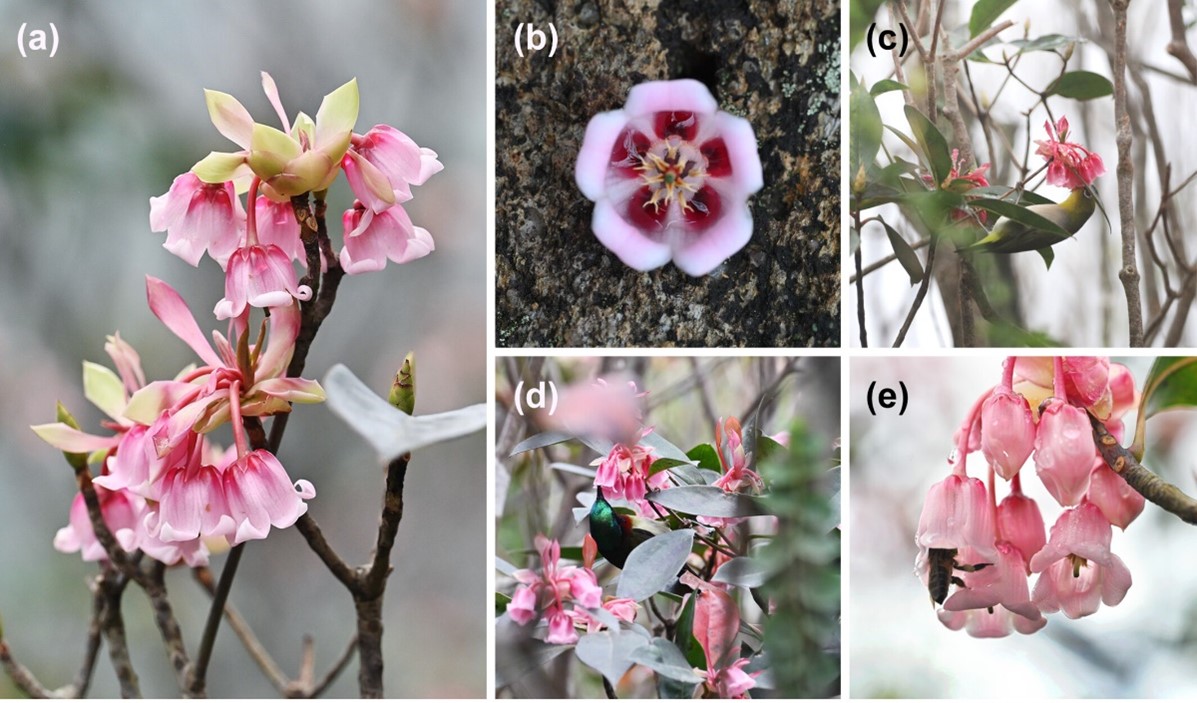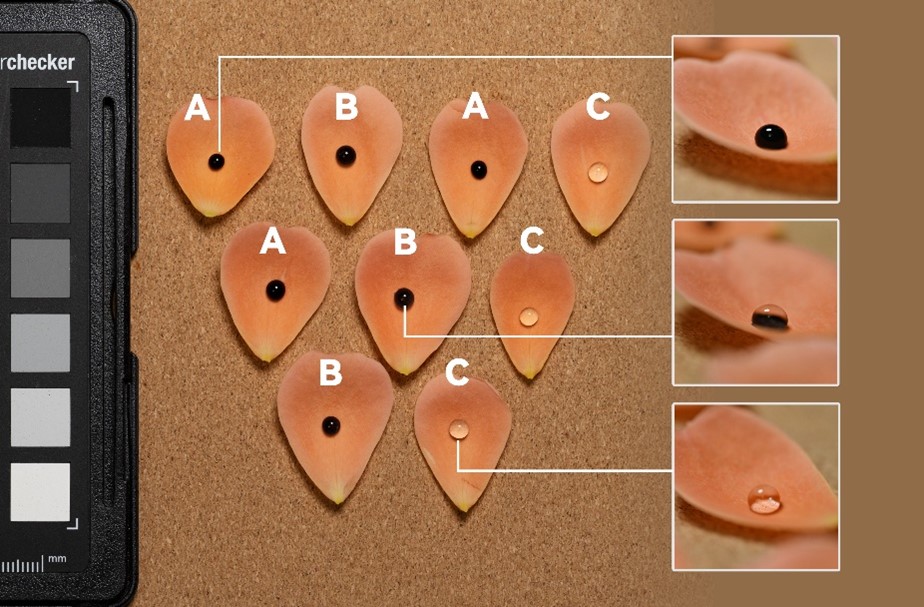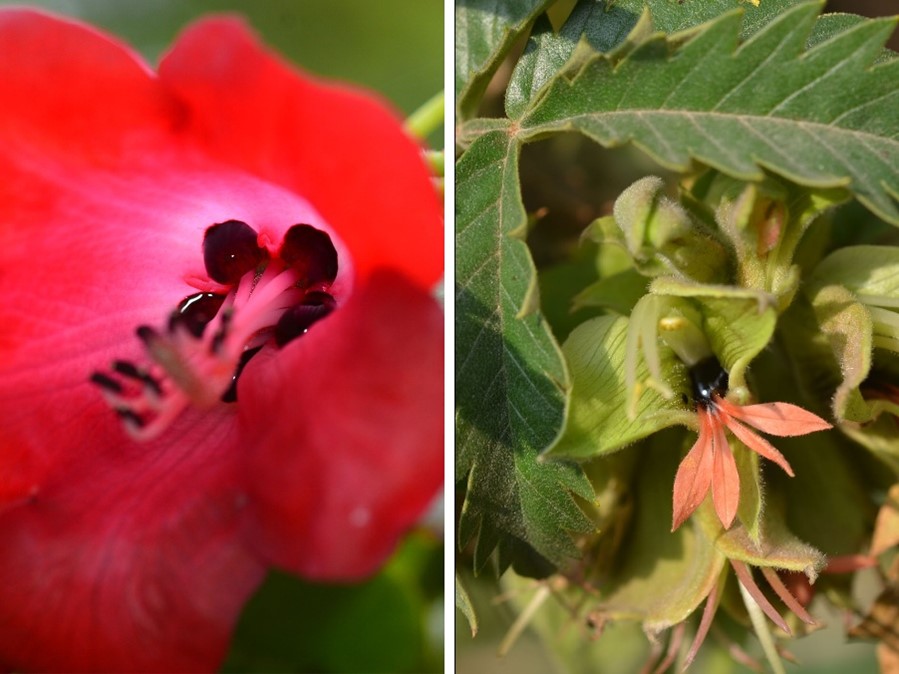Humans enjoy sweet drinks, and some animals, too, are drawn to floral “sweet water,” making them important pollinators. Most nectar is colorless, but a few plants produce more conspicuous colored nectar to attract pollinators. It has been proposed that colored nectar may function as an honest signal, helping pollinators associate nectar color with reward, thereby enhancing pollination efficiency.
Many flowers with colored nectar are bird-pollinated. However, synthesizing pigments incurs additional reproductive costs, and animals may easily discern which flowers are nectar-depleted and avoid them, potentially reducing visitation. So, how can plants make nectar more visually conspicuous without revealing whether it's been consumed—thus attracting more visits?
The Chinese New Year flower Enkianthus quinqueflorus is a beloved ornamental in South China. Around the Lunar New Year, it blooms with adorable pink flowers. At the base of these translucent bell-shaped corollas are five shiny, dark red nectar pouches. While the nectar itself is colorless, when paired with the dark pouches, it creates a strong visual illusion of colored nectar.
Field observations in Wutongshan, Shenzhen, recorded visits by birds, bees, butterflies, and bumblebees. Birds accounted for 65% of total visits and visited flowers more frequently than bees (34%). Cage experiments showed that preventing bird visits significantly reduced fruit set, confirming that birds are the primary and most effective pollinators. The flowers produce copious nectar with high hexose sugar content, suggesting a generalized ornithophilous pollination syndrome.

Fig 1. Dark nectar pouches paired with colorless nectar create an illusion of colored nectar (Image by KIB)
Reflectance spectrum analysis revealed a strong color contrast between the pouches and the nectar from a bird’s visual perspective. To experimentally recreate the illusion of colored nectar, researchers used two treatments on cut rose petals: one group received a black ink spot (true colored nectar mimic), and another had a black dot marked with a waterproof pen and a drop of clear water on top (visual mimic). Human participants (n = 20), viewing from a vertical angle simulating a bird’s view into a flower, judged the two versions as highly similar. This confirmed that dark backgrounds combined with clear liquid can effectively mimic colored nectar.

Fig 2: A: Ink (true group) B: Water + dark background (mimic group) C: Water (control group)
(Image by KIB)
Do similar traits appear in other taxa? Are those also bird-pollinated? Researchers from Kunming Institute of Botany, Chinese Academy of Sciences (KIB/CAS) reanalyzed pollination data from 37 published Rhododendron species using generalized linear models.
The team found that bird visitation was positively associated with the presence of dark nectar pouches. In contrast, bees more frequently visited species without dark pouches, and bumblebee visitation was unaffected.
Phylogenetic evidence suggests that dark nectar pouches evolved multiple times independently within the genus. Interestingly, colored nectar and dark pouches do not co-occur, and no reports of colored nectar exist in Ericaceae to date.

Fig 3: Left: Rhododendron cerasinum with dark nectar pouches Right: Melianthus dregeanus with true colored nectar (Image by KIB)
Previous studies suggested that bird-pollinated flowers lack nectar guides due to the visual acuity of birds. However, dark nectar pouches may serve a similar function. Specialist bird-pollinated flowers often have long corolla tubes and lack nectar guides, while generalized bird-pollinated flowers have open corollas with high color contrast—possibly to aid recognition and visitation by less specialized pollinators.
Dark nectar pouches and “fake colored nectar” may not act as honest signals of reward. In fact, researchers observed birds probing nectarless flowers, indicating they can be deceived by the mimic. Colored nectar requires simultaneous pigment and nectar production, which is metabolically costly. In contrast, dark nectar pouches may offer a more stable and less costly visual cue—a functional alternative to colored nectar.
This research, titled "Dark nectar pouches are visually similar to colored nectar in bird-pollinated flowers", was recently published in the journal Ecology. Dr. NIU Yang from KIB/CAS is the first author; Prof. SUN Hang is the corresponding author. PhD candidates LIN Liewen, LIU Yifeng, Dr. CHEN Zhe, and Dr. QIAN Lishen also contributed to the study. Fieldwork was supported by the Shatoujiao Forest Farm in Shenzhen.
A photo feature of the study was also published in The Bulletin of the Ecological Society of America.
Contact:
YANG Mei
General Office
Kunming Institute of Botany, CAS
email: yangmei@mail.kib.ac.cn
(Editor: YANG Mei)




